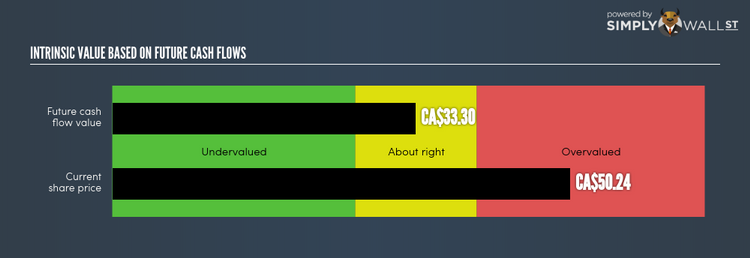Is Thomson Reuters Corporation (TSE:TRI) Worth $50.24 Based On Intrinsic Value?

Pricing capital market stocks such as TRI is particularly challenging. Given that these companies adhere to a different set of rules relative to other companies, their cash flows should also be valued differently. Maintaining a certain level of cash capital ratio is common for these financial firms to abide by, in order to minimize risks to their shareholders. Focusing on line items such as book values, in addition to the return and cost of equity, may be suitable for determining TRI’s valuation. Below we’ll take a look at how to value TRI in a reasonably useful and uncomplicated way. Check out our latest analysis for Thomson Reuters
What Is The Excess Return Model?
Before we begin, remember that financial stocks differ in terms of regulation and balance sheet composition. Canada’s financial regulatory environment is relatively strict. Furthermore, capital markets generally don’t possess substantial amounts of tangible assets on their balance sheet. This means the Excess Returns model is best suited for calculating the intrinsic value of TRI rather than the traditional discounted cash flow model, which has more emphasis on things like capital expenditure and depreciation.
Deriving TRI’s True Value
The central assumption for this model is that equity value is how much the firm can earn, over and above its cost of equity, given the level of equity it has in the company at the moment. The returns in excess of cost of equity is called excess returns:
Excess Return Per Share = (Stable Return On Equity – Cost Of Equity) (Book Value Of Equity Per Share)
= (10.9% – 8.43%) * $18.59 = $0.46
We use this value to calculate the terminal value of the company, which is how much we expect the company to continue to earn every year, forever. This is a common component of discounted cash flow models:
Terminal Value Per Share = Excess Return Per Share / (Cost of Equity – Expected Growth Rate)
= $0.46 / (8.43% – 2.13%) = $7.3
Combining these components gives us TRI’s intrinsic value per share:
Value Per Share = Book Value of Equity Per Share + Terminal Value Per Share
= $18.59 + $7.3 = CA$33.3
Given TRI’s current share price of $50.24, TRI is currently overvalued. This means TRI isn’t an attractive buy right now. Valuation is only one side of the coin when you’re looking to invest, or sell, TRI. Fundamental factors are key to determining if TRI fits with the rest of your portfolio holdings.
Next Steps:
For capital markets, there are three key aspects you should look at:
Financial health: Does it have a healthy balance sheet? Take a look at our free bank analysis with six simple checks on things like leverage and risk.
Future earnings: What does the market think of TRI going forward? Our analyst growth expectation chart helps visualize TRI’s growth potential over the upcoming years.
Dividends: Most people buy financial stocks for their healthy and stable dividends. Check out whether TRI is a dividend Rockstar with our historical and future dividend analysis.
For more details and sources, take a look at our full calculation on TRI here.
To help readers see pass the short term volatility of the financial market, we aim to bring you a long-term focused research analysis purely driven by fundamental data. Note that our analysis does not factor in the latest price sensitive company announcements.
The author is an independent contributor and at the time of publication had no position in the stocks mentioned.

